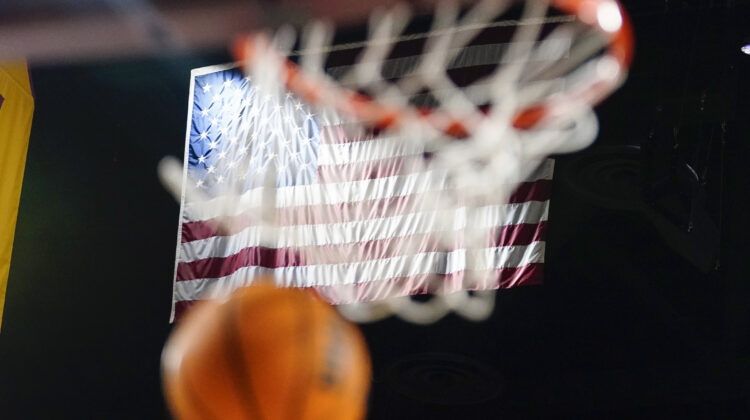LAS VEGAS — NCAA president Charlie Baker took his case for reform to the public on Wednesday. He was compelling, candid, feisty, passionate and so very real — everything his predecessor, Mark Emmert, never was or could be.
The proposal creates a subdivision for the top football programs and allows athletes to be paid directly from their schools. It would radically change college sports generally and college football specifically.
It’s exactly what the association needs, only years too late. It’s proactive but defensive, impressively creative but rooted in desperation.
“We need to be able to anticipate where conversations are going and to try to get this big, huge, diverse (association) with 2,000 members … to a place where they’re talking about stuff that’s common and not just responding and reacting to other people’s agendas,” Baker said Wednesday during a hotly anticipated appearance at the Sports Business Journal’s Intercollegiate Athletic Forum.
Essentially, Baker has called a Hail Mary from the sideline that many key constituents did not see coming.
“It was not sent to commissioners,” the SEC’s Greg Sankey said hours after Baker’s on-stage appearance.
As of yet, Baker’s Hail Mary has no formation, no snap count and no protection scheme. The players are simply running onto the field to begin the process of saving college sports from the mounting legal challenges that threaten to decimate the system.
The framework sounds intriguing:
— Allow schools to opt into, or out of, the subdivision.
— Permit players to be paid directly by the schools for their name, image and likeness (NIL), instead of from the booster collectives that have corrupted the recruiting process (which was, of course, already corrupt).
— Create educational trust funds for at least half of each school’s athletes. Each fund would require annual investments of at least $30,000.
Baker’s proposal would require compliance with Title IX but is intentionally open-ended. The athletes could use the trust fund cash however they want, whenever they want; schools could invest as much as they want so long as they met the minimum; and the subdivision could create its own competitive framework with regard to roster sizes and other policies.
While Baker used a specific dollar figure ($30,000), the proposal was light on details.
He termed it a “conversation starter.”
Big 12 commissioner Brett Yormark called it “directionally correct.”
Now comes the hard part: Ramming a revolutionary proposal through the NCAA’s labyrinthine legislative process that features multiple divisions, hundreds of committees and a membership that includes both Alabama and Alabama A&M.
How many of the 133 major college football schools would opt into the new subdivision?
The investment required would be substantial. For many universities, paying half the athletes $30,000 annually becomes a $6 million budget hit — and that’s the minimum. There’s no cap, so some schools could pay double or triple the proposed amount. (Hello, SEC!) Add the NIL compensation piece, and it’s easy to see the cost zooming past $10 million annually.
Within the Pac-12 footprint, USC, Oregon and Washington would opt in. They have the resources, brand names and fan passion to make subdivision membership a community imperative.
Others would join, as well. But to what degree? Could schools with budget issues (Arizona, Cal, UCLA, Oregon State and Washington State) offer competitive investments in the trust funds?
Would Arizona State, Utah and Colorado do the same? The Utes, in particular, have always managed their money well. How would they define a reasonable investment level?
But the subdivision would require more than a mammoth cash outlay. It demands a philosophical shift. Would all the Pac-12 schools be willing to join the world of uncapped payments to athletes? Is Stanford ready to take that step? Is Cal?
Longtime NCAA watchers wondered if the autonomy provided by Baker’s subdivision might delay the endgame many foresee, with the heavyweight football programs breaking away from the NCAA in the 2030s to create their own league, a mini-NFL.
But there’s another possible outcome: The subdivisions expedite the formation of a SuperLeague by adding stress to the system and forcing universities of higher education to define their financial and institutional relationships with athletes.
Also, Baker’s proposal is unlikely to eliminate the legal challenges facing the NCAA, with the House case atop the list of existential threats.
Grant House, a former Arizona State swimmer, is the named plaintiff in a massive class-action suit against the NCAA that seeks not only NIL back-pay for thousands of athletes but also attempts to force schools into sharing a portion of their media rights money with the athletes.
The damages could carry an eight-figure cost; the revenue-sharing piece will divert millions annually in future media dollars from the schools to the athletes.
The attorneys for House aren’t likely to drop the case because Baker isn’t Emmert.
If schools must pay into the trust funds (outlined by Baker) and share media revenue with athletes (as dictated by a loss in the House case), the resulting economic pressures could hasten the arrival of the SuperLeague.
The Hotline attempts to view the subdivision proposal through the same lens used for other earth-moving developments across college sports: How will it be received in Columbus, Ann Arbor and South Bend? In Tuscaloosa, Athens and Baton Rouge? In Austin, Norman and Los Angeles?
Because the future of 2,000 schools across all NCAA divisions, and especially the 100-something athletic departments in the FBS, hinges on decisions made in coming years by the handful of bluebloods at the very top of the Power Five hierarchy.
We often describe college football with a broad brush, as the Power Five and the Group of Five, but those terms don’t reflect the sport’s true hierarchy.
In reality, the eight or 10 schools that drive billion-dollar media deals are subsidizing everyone else.
As changes take root and costs rise, so will the need for cash — and a reluctance to share their revenue with the remainder of the FBC, Division I and the entire NCAA.
Baker had no choice but to call for a Hail Mary. Problem is, the ball’s on his own 20.
*** Send suggestions, comments and tips (confidentiality guaranteed) to pac12hotline@bayareanewsgroup.
*** Follow me on Twitter: @WilnerHotline
*** Pac-12 Hotline is not endorsed or sponsored by the Pac-12 Conference, and the views expressed herein do not necessarily reflect the views of the Conference.
Related posts:
 Wilner Hotline – Former Utah AD says no reason to jump into Big 12 unless the goal is “to destroy” the Pac-12
Wilner Hotline – Former Utah AD says no reason to jump into Big 12 unless the goal is “to destroy” the Pac-12  The Hotline’s preseason AP top-25 ballot: Alabama’s No. 1, with Notre Dame and Utah lurking
The Hotline’s preseason AP top-25 ballot: Alabama’s No. 1, with Notre Dame and Utah lurking  Hotline mailbag: The true cost of the Pac-12 Networks, Big Ten timing, the need for night-game inventory and more
Hotline mailbag: The true cost of the Pac-12 Networks, Big Ten timing, the need for night-game inventory and more  Pac-12 survival: UC Board of Regents plunges into the details of UCLA’s pending departure for the Big Ten
Pac-12 survival: UC Board of Regents plunges into the details of UCLA’s pending departure for the Big Ten
